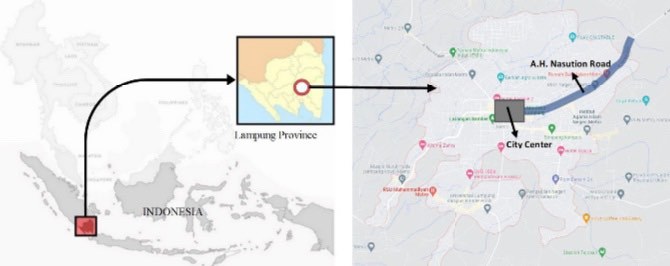Study on the Potential of Historical Mahogany Trees in Improving Urban Air Quality
DOI:
https://doi.org/10.56261/built.v19.246492Keywords:
Mahogany, Sequestration, Metro City, Carbon, Emission, SDGs, UrbanAbstract
Metro City is one of the cities in Lampung Province, Indonesia, which has experienced various infrastructure development which contributed to the decrease of the air quality. Urbanization also causes constant decrease in term of the number of green open spaces.
Yet green open space plays an important role in maintaining urban air quality. Vegetation (i.e., tree) as the main component of green open space has the ability to absorb and store carbon emission. In Metro city, there is a major green open space that includes numerous large-sized Mahogany trees lining along A.H. Nasution Road. The purpose of this study was to estimate the level of air pollution from emissions of the passing-by motorized vehicles, calculate the capacity of carbon sequestration by the Mahogany trees, and determine the potential of the Mahogany trees in improving air quality. Authors collected primary data on the diameter of the tree trunks and the number of passing-by vehicles to estimate the carbon-storing capacity and carbon emission by utilizing allometric equation and emission load analysis. This study concluded that the Mahogany trees could play an important role on storing 74% of expected annual CO2 emission in Metro City. This could be linked to the achievement of the SDGs especially Target 11.6.
Downloads
References
Adinugroho, W. C., & Sidiyasa, K. (2006). Model Pendugaan Biomassa Pohon Mahoni (Swietenia macrophylla King) di Atas Permukaan Tanah [Biomass Estimation Model of Above Ground Mahogany (Swietenia macrophylla King) Tree], 103-117.
Agus Ruliyansyah, Yulisa Fitrianingsih, L. H. V. (2013). Analisis Kebutuhan Ruang Terbuka Hijau (RTH) Berdasarkan Serapan Gas Co2 di Kota Pontianak. Jurnal Teknologi Lingkungan Lahan Basah, 1(1), 1–10. https://doi.org/10.26418/jtllb.v1i1.2105
Bismark, M., Subiandono, E., & Heriyanto, N. M. (2008). Keragaman dan Potensi Jenis serta Kandungan Karbon Hutan Mangrove di Sungai Subelen Siberut, Sumatera Barat. Jurnal Penelitian Hutan Dan Konservasi Alam, 5(3), 297–306. https://doi.org/10.20886/jphka.2008.5.3.297-306
Hairiah K, Ekadinata A, Sari RR, Rahayu S. 2011. Pengukuran Cadangan Karbon: Dari Tingkat Lahan ke Bentang Lahan. Petunjuk Praktis. Edisi kedua. Bogor, World Agroforestry Centre, ICRAF SEA Regional Office, University of Brawijaya (UB), Malang, Indonesia.
Harunsyah. (2017). Jurnal Reaksi (Journal of Science and Technology) Jurusan Teknik Kimia Politeknik Negeri Lhokseumawe Vol. 15 No.02, Desember 2017 ISSN 1693-248X. 15(02), 1–5.
Manado, D. I. K., Momongan, J. F., Gosal, P. H., & Kumurur, V. A. (2017). Efektivitas Jalur Hijau Dalam Menyerap Emisi Gas Rumah Kaca Di Kota Manado. Spasial, 4(1), 36–43.
Martuti, N. K. T. (2013). Peranan Tanaman terhadap Pencemaran Udara di Jalan Protokol Kota Semarang (The Role of Plants Against Air Pollution in The Protocol Street of Semarang City). Biosantifika, 5(1), 37–42.
Nuzir, F. A. (2021). Promoting Mahogany Trees as the Landscape Heritage in Metro City onto Achieving SDG 11. SDGs Conference International Science Consortium for Indonesian Sustainability (ISCIS), 2004, 99–120. http://artikel.ubl.ac.id/index.php/pm/article/view/1394
Nuzir, F. A. (2022). Virtual Observation of the Mahogany Trees to Promote Its Conservation as the Landscape Heritage of the Colonization Period in Metro City, Lampung [Unpublished manuscript]. Humboldt Kolleg Urban Partnership Melting Pot. Universitas Pembangunan Jaya, Jakarta, Indonesia.
N. Matsumoto, “Development of Environmentally Sustainable Transport Systems in Urban Areas” in APEIS/RISPO Final Report, IGES, Hayama, 2005, pp. 208-256.
Picard, N., Saint-André, L., & Henry, M. (2012). Manual for Building Tree Volume and Biomass Allometric Equations: From Field Measurement to Prediction. (Manual). Montpellier, France: Food and Agricultural Organisation of the United Nations (FAO); Centre de Coopération Internationale en Recherche Agronomique pour le Dévelopment (CIRAD).
Rawung, C. F. (2015). Efektivitas Ruang Terbuka Hijau (RTH) dalam Mereduksi Emisi Gas Rumah Kaca (GRK). Jurnal Media Matrasain, 12(2), 17–32.
Rinjani, A. R., Setyaningsih, L., & Rahman, A. R. (2016). Potensi Serapan Karbon di Jalur Hijau Kota Bogor. Nusa Sylva, 16(1), 32–40.
Salsabilli, C. P. S., Widiastuti, E. L., Wahyuningsih, S. (2019). Carbon Stock Estimation Due to Changes in Mangrove, Labuhan Maringgai District, East Lampung Regency. Advances in Engineering Research, volume 202, 6-10.
Suryani, Y., & Damayanti, A. (2014). Analisa Kemampuan Jalur Hijau Jalan Sebagai Ruang Terbuka Hijau (RTH) Publik untuk Menyerap Emisi Karbon Monoksida (CO) dari Kendaraan Bermotor di Kecamatan Genteng, Surabaya. Jurusan Teknik Lingkungan, Fakultas Teknik Sipil Dan Perencanaan, Institut Teknologi Sepuluh Nopember (ITS) Kampus ITS Sukolilo, Surabaya.
Sutarni, M. S. (1995). Flora Eksotika Tanaman Peneduh. Penerbit Kanisius.
Tuah, N., Sulaeman, R., & Yoza, D. (2017). Penghitungan Biomassa dan Karbon di Atas Permukaan Tanah di Hutan Larangan Adat Rumbio Kabupaten Kampar. Jurnal Online Mahasiswa Fakultas Pertanian Universitas Riau, 4(1), 1–10.
Yuyun, Nuzir, F. A., Dewancker, B. J. (2017). Dynamic Land-Use Map Based on Twitter Data. Sustainability, 9(12), 2158.

Downloads
Published
How to Cite
Issue
Section
License
Copyright (c) 2022 International Journal of Building, Urban, Interior and Landscape Technology (BUILT)

This work is licensed under a Creative Commons Attribution-NonCommercial-NoDerivatives 4.0 International License.











